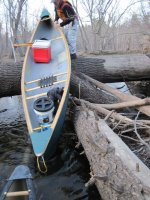Howdy,
Does a canoe move through the water smoother, easier and faster with a brand new paint job on the hull?
My old Sawyer with it's faded, chalky, heavily scratched up gel coat seems kinda doggy to me.
I'm doing a little body work, and a few repairs then it's getting a new coat of red.
I hope it's a bit speedier with a slicked up bottom.
Does a canoe move through the water smoother, easier and faster with a brand new paint job on the hull?
My old Sawyer with it's faded, chalky, heavily scratched up gel coat seems kinda doggy to me.
I'm doing a little body work, and a few repairs then it's getting a new coat of red.
I hope it's a bit speedier with a slicked up bottom.

